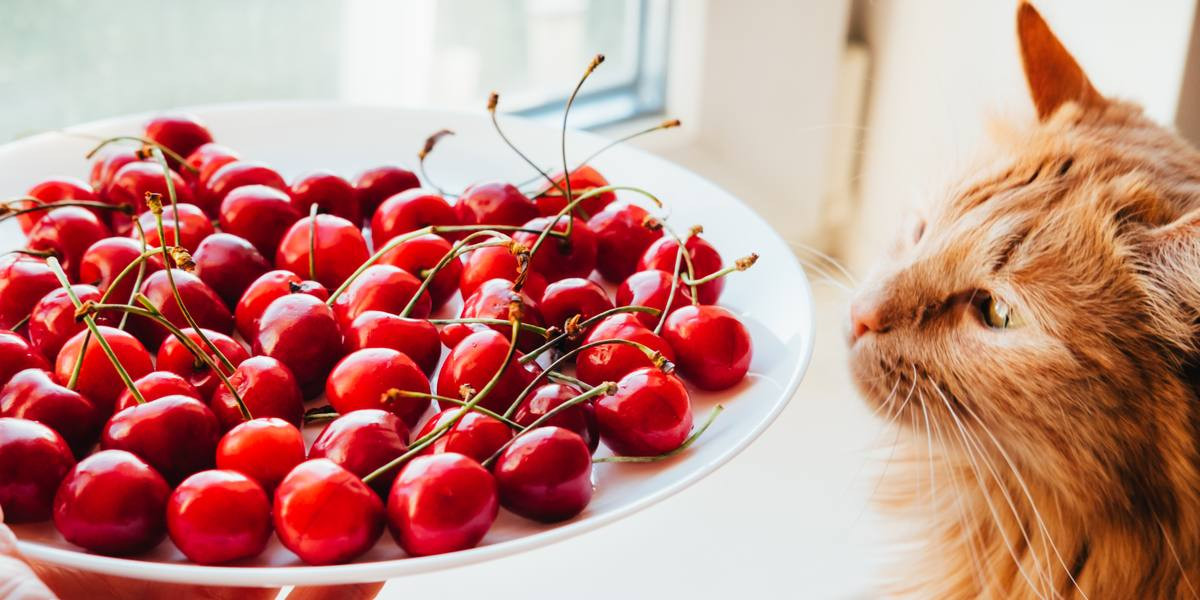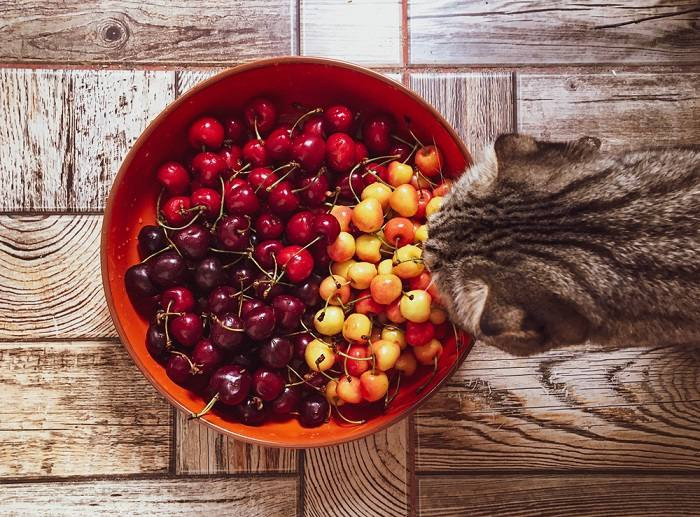 A curious cat investigates a pile of bright red cherries, highlighting the question of cherry safety for felines
A curious cat investigates a pile of bright red cherries, highlighting the question of cherry safety for felines
Cherries, with their juicy sweetness, are a delightful summer treat for many humans. From sweet Bing cherries to tart Montmorency varieties, these stone fruits are packed with flavor and often considered a healthy snack for us. But when it comes to our feline companions, Can Cats Eat Cherries too?
The answer, unfortunately, is a resounding no. While the fleshy part of a ripe cherry might not be immediately lethal to your cat, there are significant dangers lurking within this seemingly innocent fruit. The risks associated with cherry pits, stems, and leaves far outweigh any potential, and frankly non-existent, benefits for your feline friend. Therefore, it’s crucial to understand why cherries and cats are a dangerous combination and why it’s best to keep these fruits far away from your curious kitty.
Quick Look: Cherries and Cats – Not a Safe Mix
Toxic: Yes
Commonly Allergenic: No
Species Appropriate: No
How Often to Feed: Never
How Much to Feed: None
Key Takeaway: Cherries Pose a Danger to Cats
Despite being celebrated for their health benefits for humans, cherries are not a safe treat for cats. The potential for cherry poisoning from various parts of the fruit makes it essential to prevent your cat from consuming any part of a cherry plant. Protect your feline family member by keeping cherries and cherry trees out of their reach.
Read More: Looking for safe fruit options for your cat? Explore: Which Fruits Can Cats Eat?
Are Cherries Healthy for Cats? The Nutritional Myth
 A cat cautiously approaches a bowl of cherries, illustrating the need to keep cherries away from cats
A cat cautiously approaches a bowl of cherries, illustrating the need to keep cherries away from cats
In human nutrition, cherries are often lauded as a superfood. They are rich in antioxidants and vitamins, and are linked to benefits like improved sleep, weight management, and reduced inflammation. Cherries also contain fiber and potassium, nutrients that are beneficial for human digestive health, blood pressure, and hydration. Furthermore, cherries contain Vitamin C, important for skin, bone, and blood vessel health in humans.
However, when we consider cats, these nutritional advantages become irrelevant, and even misleading. Cats are obligate carnivores, meaning their dietary needs are fundamentally different from humans. They primarily require nutrients from animal protein. While fruits can offer some vitamins and fiber, cats are not biologically designed to process plant-based nutrients in the same way humans are.
More importantly, the risks associated with cherries for cats far outweigh any negligible nutritional benefits they might theoretically gain from the fruit’s flesh. There are much safer and more species-appropriate ways to ensure your cat receives all the necessary vitamins and minerals through a balanced cat food and cat-safe treats.
How Many Cherries Can Be Toxic to a Cat? Understanding the Poison Risk
Due to the serious risk of cyanide poisoning from cherry plants, it’s crucial to understand that any amount of cherry consumption can be potentially dangerous depending on which part of the fruit is ingested. It’s not about a safe quantity; it’s about avoiding cherries altogether.
If your cat has eaten any part of an unripe cherry, a cherry with the pit or stem, or any other part of the cherry plant like leaves or flowers, immediate veterinary attention is necessary. These parts contain cyanogenic glycosides, which the body converts to cyanide.
Even if your cat manages to eat only the flesh of a ripe, seedless cherry, it’s still wise to be vigilant. While the flesh itself has a lower cyanide concentration, accidental ingestion of a pit fragment is always a possibility. Closely monitor your cat for any signs of illness and contact your veterinarian immediately if you notice anything unusual.
Learn More: Protect your feline friend by knowing: 10 Toxic & Poisonous Plants For Cats
Cherry Consumption Frequency: Why “Never” is the Safest Answer
Even a single cherry can pose a significant threat to your cat if it contains the pit, stem, or is underripe. These components contain cyanide, a potent poison that can be fatal to cats, even in small amounts. To completely eliminate this risk, the safest approach is to never offer cherries to your cat and ensure that any cherries in your home or garden are completely inaccessible to them.
While dried cherries might seem like a less risky option because they are typically pitted, it’s still not worth the gamble. There’s always a chance of residual pit fragments, and safer, cat-appropriate treats are readily available.
If you are looking for antioxidant-rich human foods to share with your cat, consider completely safe alternatives like blueberries, which are a recommended and feline-friendly option.
Do Cats Even Like Cherries? Taste Preferences and Feline Instincts
Cats are obligate carnivores, and their taste preferences reflect this biological need for animal protein. Their palates are not naturally attuned to sweet flavors in the same way human palates are. While some cats might be curious and nibble at a cherry out of curiosity, most cats are unlikely to be inherently drawn to the taste of cherries.
Even if your cat seems interested in cherries, it’s crucial to prioritize their safety over their fleeting curiosity. Always verify the safety of any human food before offering it to your feline companion. Just because a cat might eat something, doesn’t mean it’s safe or beneficial for them.
Cherries in Commercial Cat Food: A Rare and Risky Ingredient
You will not find cherries listed as an ingredient in high-quality commercial cat food formulations. This is because, despite the non-toxic nature of cherry flesh in small amounts, the inherent dangers associated with other parts of the cherry plant make it an unsuitable and risky ingredient for cat food.
The potential for cyanide poisoning from cherry pits, stems, and leaves is a significant concern that manufacturers wisely avoid. Instead, cat food is formulated with ingredients that are both safe and nutritionally beneficial for cats, focusing on animal-based proteins and essential nutrients.
If you are seeking safe fruit options to supplement your cat’s diet (in very small amounts and as occasional treats), consider feline-friendly fruits like blueberries, strawberries, or watermelon, always ensuring they are seedless and offered in moderation.
Are Cherries Truly Bad for Cats? Understanding the Health Risks
Cherries are not inherently poisonous in their flesh, but the risk of cyanide poisoning from other parts of the cherry plant makes them definitively bad for cats. Both sweet and tart cherry plants contain cyanogenic compounds in their stems, leaves, seeds (pits), and flowers.
While the ripe cherry flesh contains a significantly lower concentration of cyanide, the pit inside still harbors a dangerous amount. If a cat ingests cherry pits, stems, or leaves, they can develop cyanide poisoning. Symptoms of cyanide poisoning in cats include difficulty breathing, vomiting, dilated pupils, drooling, and muscle spasms. Tragically, cyanide poisoning can be fatal for cats, especially without prompt veterinary intervention. Other fruits that contain cyanide and are dangerous for cats include apricots and apples (especially apple seeds).
Beyond cyanide poisoning, cherry pits also present a choking hazard and can cause intestinal blockages if swallowed. Furthermore, introducing any new food into a cat’s diet can potentially cause digestive upset.
Finally, remember that treats should only constitute a small percentage of a cat’s daily caloric intake. Overfeeding treats, even if they were safe, can unbalance your cat’s diet and lead to nutritional deficiencies over time. Therefore, considering all the risks and lack of benefits, feeding cherries to your cat is never a good idea.
Further Reading: Learn more about safe and unsafe foods for cats: Are Fruits And Vegetables Safe For Cats? What Every Cat Owner Should Know
In Conclusion: Cherries and Cats Don’t Mix – Prioritize Feline Safety
Cherries, while a delightful human treat, pose significant health risks to cats due to the presence of cyanide in their pits, stems, and leaves. The potential for cherry poisoning, choking hazards, and digestive upset makes it crucial to keep cherries and cherry plants away from your feline companions. Prioritize your cat’s safety and well-being by choosing cat-safe treats and ensuring they receive a balanced diet formulated for their specific nutritional needs. When it comes to cherries and cats, avoidance is always the best policy.
Frequently Asked Questions About Cats and Cherries
Is it safe for cats to eat cherry flesh?
While the flesh of a ripe, seedless cherry is less likely to contain harmful levels of cyanide, it’s still not worth the risk. The possibility of trace amounts of cyanide and the potential for accidental ingestion of pit fragments make cherries a risky treat. It’s always best to err on the side of caution and choose completely safe, cat-appropriate treats. Remember, all other parts of the cherry, including stems, leaves, flowers, and especially the pits, are toxic to cats.
Can cats eat cherries if the pits are removed?
Even with the pits removed, it’s generally not recommended to feed cherries to cats. While the risk of cyanide poisoning is reduced with pit removal, there’s still a potential risk from residual cyanide in the flesh, and cherries offer no significant nutritional benefits to cats. Safer and more appropriate treat options are readily available for your feline companion.

